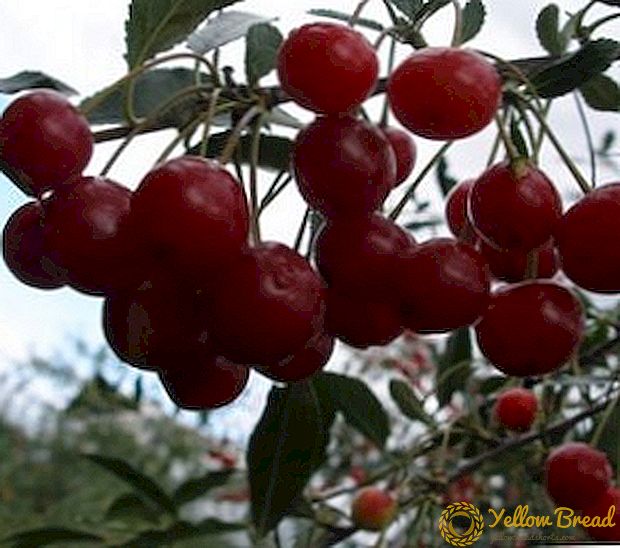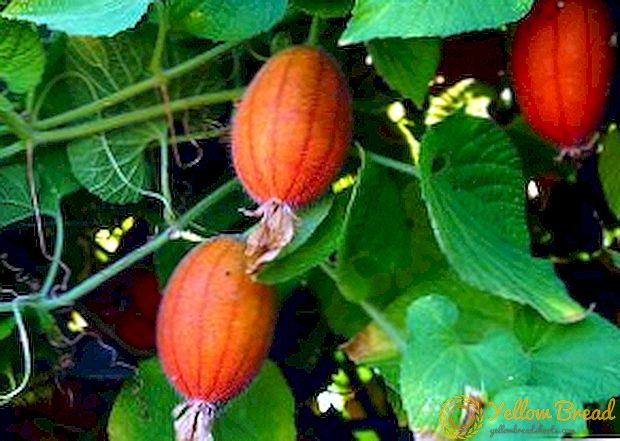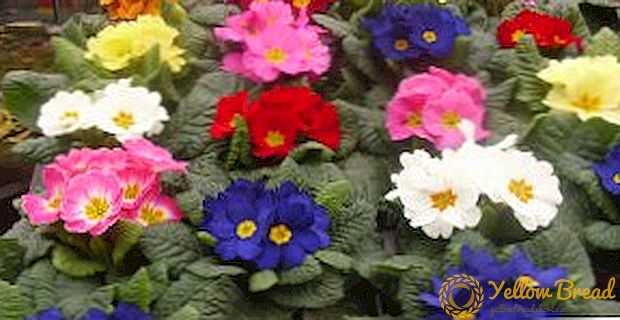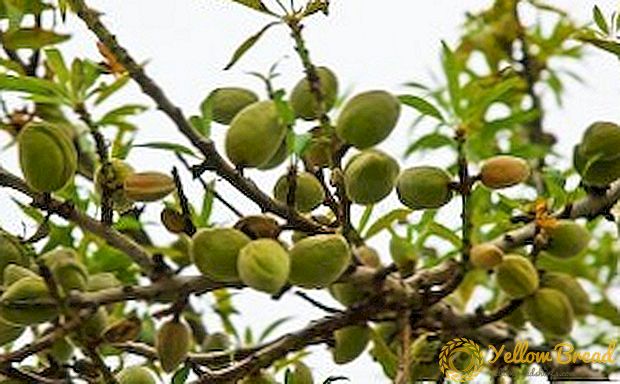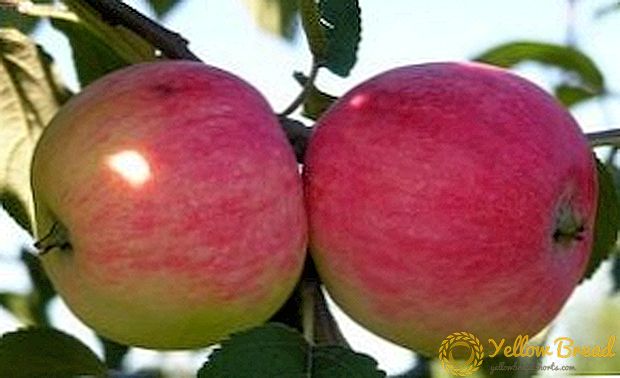
This article reveals all the features of such a wonderful variety of summer apples as "Melba" (or "Melba"). All the experience of gardeners, collected here specifically to provide you with the most accurate and practical information about it.
We will discuss all the advantages and disadvantages of this variety, as well as focus on the features of planting trees and tree care in all periods of the year.
- All the secrets of apple varieties "Melba"
- Fruits of apple varieties Melba: description of apples
- Recommended use of fruits
- Features of the apple tree "Melba"
- How do shoots of this variety differ?
- Virtues of apple
- Disadvantages of Melba
- We carry out the correct planting of apple sapling "Melba"
- Features of the arrangement of rows of trees
- Soil requirements
- When and how to plant the Melba seedlings?
- We provide an apple tree with good care and a good harvest.
- Fertilize the tree
- Digging
- Go to trimming branches.
- Whitewashing - tree protection
- Do I need care in winter
All the secrets of apple varieties "Melba"
This variety of apples is very common throughout the middle climatic zone and is perfect for growing on the territory of Ukraine, Belarus and Russia (with the exception of the North, the Urals and the Far East).
The variety was obtained by sowing freely pollinated apple seeds "Makentosh". Differs special taste of fruits that ripen in the second half of August.
However, if you are going to plant Melba on your plot, it is useful to find out more detailed data about this variety, which we want to give you.
Fruits of apple varieties Melba: description of apples

A distinctive feature of these apples is their average size and a rounded conical shape, in which the widest part is the base. Also, their characteristic ribbing throughout the surface of the fetus. The surface of the skin is very smooth and tender to the touch, which is ensured by the presence of a wax coating.
The main color of Melba apples is light green with a cover of striped red "blush", which occupies half of the skin surface. The fetus is clearly visible subcutaneous points of white, although their size is not large.
The funnel of a ripe fruit is deep, but not particularly wide, with a thin middle stem. The saucer of apples is narrow, has an average depth. The cup of the saucer is closed. The heart is not large, in shape resembles an onion.In the seed chambers are stored large enough seeds of elongated shape, painted in brown.
Particular attention should be paid to the taste of ripe fruit. Taste the pulp of apples "Melba" sweet and sourbut has a strong candy flavor and aroma. Differs in special juiciness and tenderness. The color of the pulp is snow white.
The amount of ascorbic acid, which is included in the chemical composition of fruits, averages 13.4 mg per 100 grams of pulp.
Recommended use of fruits
Ripened fruit of the apple "Melba" is recommended to use in the preparation of compotes and juices. This possibility of using fruits is provided by a large amount of juice in apples.
Also, ripe fruits are suitable for transportation and have a high presentation. Stored in cold conditions (in refrigerators) they can up to three to four months.
Features of the apple tree "Melba"
Trees of this variety differ in medium height, which should be taken into account when setting up a garden and allow placing a sufficiently large number of seedlings in small areas.
The crown of the tree has a rounded shape, the branches of which have a brownish-brown bark. Fruiting occurs in a mixed type., but basically the largest number of fruits tied on kolchatkah.
Young trees are straight but thick in the trunk. Their bark has a light cherry color.
How do shoots of this variety differ?

The thickness of the shoots of the apple is average, in shape they are srednepuschennye
Leavesthat are formed on the shoots have an oblong oval shape. In general, they are almost straight, but on large and strong shoots they can transform into a strongly convex shape and swell to the top. The color of the leaves is net green, sometimes with a yellowish tinge.
Flowering occurs in large budswhich are painted in white and pink with a purple tinge. The petals in the flower have a pinkish color, rounded in shape, close and slightly find one over the other.
Virtues of apple
A distinctive feature due to which many gardeners prefer the variety "Melba" is his precociousness. Sufficient quality fruits can be obtained from a tree for 4-5 years. You can pick ripe fruit at the end of the summer.
The grade plus is also high yieldwhich occurs in young trees every year. In particular, when placing trees 8x3 meters, average yield is about 93 centners per hectare. With wider indents between the trees, the average yield may increase by another 80 centners.
It is worth recalling once again the possibilities of processing fruits and their high presentation.
Disadvantages of Melba
Since this variety is suitable for planting only in the middle lane, its low temperature resistance medium. Thus, even in suitable latitudes, the tree has to be protected from frost.
Also, trees are prone to scab damage, which can both significantly damage the tree, and affect the yield.
It is worth considering that adults and old trees can bear fruit periodically, which clearly reduces the merits of the variety.
We carry out the correct planting of apple sapling "Melba"
If you are going to plant an apple tree of this variety, it is worth noting once again not only the beautiful rounded crown of the tree, which will decorate your garden, but also its fear of low temperatures. These factors greatly influence the choice of region for planting a tree.
Features of the arrangement of rows of trees
Apple "Melba" should be planted in rows of 8x3 meters, to give the crown enough space to grow and not shade the tree during the fruiting and flowering period.
If you intend to use the space between the trees for planting various vegetable crops and increase the yield of the variety, you should plant the seedlings in a square scheme of 7x7 meters.
Soil requirements
This variety is preferred to soils with good drainage system. I.e, the tree is afraid of groundwaterthat can come close to the surface. Therefore, planting an apple tree should choose a hilly surface or dig a special groove near the garden that will regulate the groundwater level.
Most suitable soil type for "Melby" are loamy soilsin which the apple tree will give the most abundant harvests.
When and how to plant the Melba seedlings?
The peculiarity of this variety is that realize him landing is recommended in the middle of autumnabout a month before the first real frosts.
Pit for planting preparing in advance. When digging a hole, keep in mind that you will need to put a fertilizer mixture at the bottom, so its depth must be at least 70 centimeters. True, it is necessary to take into account also the root system of the seedling: if it is very large, the pit should correspond.
The width of the pit should be approximately 1 meter. It is recommended to divide the land out of it into two parts, in one tilting the upper fertile layer, and in the second - the lower one. Having dug a hole, it is recommended to put tin cans and a shell of walnuts in it.
Direct planting seedlings carried out about a week or two after preparing the pit. A mixture of topsoil with various fertilizers, such as peat and humus, is poured on the bottom. Falling asleep pit, slightly condense it.
If your seedling is very small and there is no wind protection around it, recommended along with the seedling to dig a hole countto which a small tree is tied. Thus, you will save it from the strong winds and from possible damage by animals.
We provide an apple tree with good care and a good harvest.
Care for the tree should be regular and take into account all the features of the season.
Fertilize the tree

There are no special requirements for fertilizer. If you planted a seedling in fertile soil, then in the first year you should not do it at all.
Then the tree will be fertilized with nitrogen in the summer and laying a tree trunk before winter with humus and peat. At what, the trunk of a tree is wrapped in fertilizers right in front of the frosts in order to prevent nutrient compounds from reaching the roots and not to cause undue growth.
Also, A great fertilizer for apple trees are mixtures of superphosphate and potassium, sodium chloride, and ash.. If you are making liquid fertilizer from the indicated preparations and substances, then it is recommended to bring it not under the tree, but into a groove dug around the tree circumference, up to 10 centimeters deep.
Fallen leaves, old grass, which can also be dumped on the ground around the trunk of an apple tree, will also serve as good fertilizer.
Digging
Dig the ground should also be regularly in the fall and spring. This will provide the tree with the necessary amount of oxygen and will accelerate the ingress of fertilizer to the root system.
Go to trimming branches.
Trim branches apple trees are better in the springwhen the tree is just starting to blossom. Cuts are all unnecessary and hindering the growth of the main branches. It is important to create a beautiful and correct crown with the help of cutting that will allow you to conveniently harvest a mature crop.
Whitewashing - tree protection
Whitening tree stands in the middle of autumn. Thus, you will protect the tree not only from various diseases, but also from parasites. Whitening costs from the lowest branches to the bottom. A young sapling can be whitewashed completely, since it is especially vulnerable to various diseases and pests.
Do I need care in winter
Weak winter-resistance of apple varieties "Melba" requires special attention in the winter. It is necessary to monitor the status of branches. If some of them die out during the winter, they must be cut off in the spring.
If a lot of snow has fallen - take pity and shove it to the trunk of the apple tree. This will not only protect the tree from frost, but also provide excellent watering in early spring. However, during the first thaw, watch for the appearance of ice crust on the snow, which can limit the flow of air to the roots and the trunk, in time to crush it.


